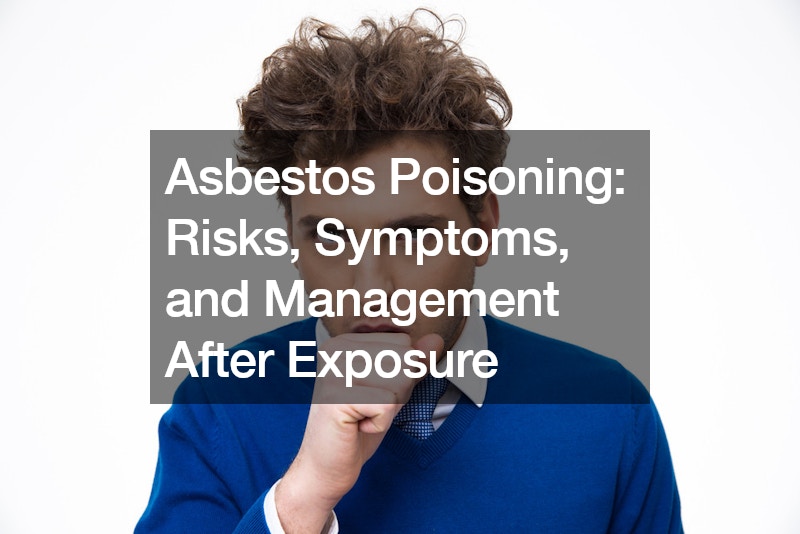Asbestos, a naturally occurring mineral once widely used in construction materials, poses a serious health threat. While its use in new buildings is banned, it remains a hidden danger in older homes and structures. Inhaling asbestos fibers, released when containing materials are damaged, can cause severe lung scarring and chronic respiratory problems. This article explores the risks of asbestos poisoning, its symptoms, and management strategies after exposure.
The Dangers of Asbestos
Asbestos exposure is linked to a variety of health complications, primarily affecting the respiratory system. Microscopic asbestos fibers are easily inhaled and lodge deep within the lungs.
The body struggles to remove these fibers, leading to chronic inflammation and scar tissue formation. This scarring disrupts the lungs’ ability to function properly, hindering oxygen exchange and causing difficulty breathing.
Health Risks Associated with Asbestos Poisoning
The severity of health risks associated with asbestos poisoning depends on the level and duration of exposure. However, some common illnesses linked to asbestos include:
- Asbestosis: This chronic lung disease results in progressive scarring, leading to shortness of breath, coughing, and chest tightness.
- Lung cancer: Asbestos exposure is a significant risk factor for lung cancer, even in individuals with no history of smoking.
- Mesothelioma: This is a rare form of cancer affecting the lining of the lungs, heart, or abdomen.
Symptoms of Asbestos Poisoning
Unlike many respiratory illnesses, asbestos poisoning often exhibits no immediate symptoms. The damage caused by asbestos fibers accumulates over years, and symptoms may not appear until decades after initial exposure. Some of the telltale signs of asbestos poisoning include:
- Shortness of breath: This is a prevalent symptom, often worsening with exertion.
- Persistent cough: A dry, hacking cough that doesn’t improve can be a sign of asbestos-related lung damage.
- Chest pain: Tightness, pain, or a scratchy feeling in the chest can occur due to inflammation and scarring.
- Wheezing: A whistling sound during breathing indicates narrowed airways, a potential symptom of asbestos exposure.
- Fingernail clubbing: In some cases, the fingertips and toenails may become wider and rounder due to reduced oxygen levels in the blood.
- Fatigue: Extreme tiredness can be a consequence of the body struggling to breathe effectively.
Importance of Early Detection
Due to the delayed onset of symptoms, early detection of asbestos poisoning is crucial. If you suspect potential exposure due to work or living in an older building, consulting a doctor is essential. They might recommend a chest X-ray, CT scan, or lung function tests to assess lung health and identify any abnormalities.
Management Strategies After Exposure
Unfortunately, there is no cure for asbestos poisoning. However, several management strategies can help control symptoms and improve quality of life. These include:
- Pulmonary rehabilitation: This program involves exercises designed to strengthen the lungs and improve breathing efficiency.
- Oxygen therapy: In more serious instances, additional oxygen may be required to boost blood oxygen levels.
- Medications: Bronchodilators can help relax the airways and ease breathing difficulties.
Living with Asbestos
If you have been diagnosed with asbestos poisoning, it’s crucial to minimize further exposure. An asbestos survey by a qualified professional is highly recommended. This survey identifies all asbestos-containing materials (ACMs) within a building or residence. Based on the survey results, appropriate steps can be taken to manage the ACMs. Depending on the extent and condition of the ACMs, this might involve encapsulation, removal, or simply avoiding disturbing the materials.
Preventing Future Exposure
For individuals living or working in older buildings, vigilance is key. Here are some tips to minimize the risk of asbestos exposure:
- Be aware of potential ACMs: Common materials that might contain asbestos include floor tiles, insulation, ceiling tiles, and textured paint.
- Avoid disturbing suspicious materials: Leave them undisturbed unless you have a certified professional assess and manage them.
- Prioritize ventilation: Maintain good ventilation in your home or workplace to reduce airborne dust and fibers.
Living a Healthy Lifestyle
While there’s no reversing the damage caused by asbestos, adopting a healthy lifestyle can significantly improve your well-being. Here are some recommendations:
- Smoking cessation: Smoking significantly increases the risks associated with asbestos exposure. Quitting smoking is crucial for lung health.
- Healthy diet: A balanced diet rich in fruits, vegetables, and whole grains provides your body with the nutrients needed to function optimally.
- Regular exercise: Regular physical activity, even gentle exercises, can improve lung function and overall health.
Conclusion
Asbestos poisoning is a serious health concern with potentially life-threatening consequences. Early detection and appropriate management strategies are critical for those who have been exposed. By remaining vigilant, minimizing exposure risks, and adopting a healthy lifestyle, individuals with asbestos poisoning can take control of their health and live a fulfilling life.
.



